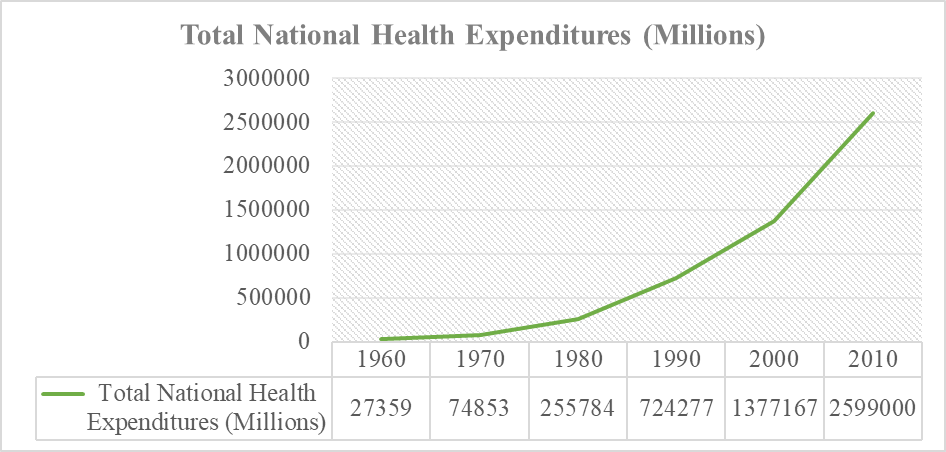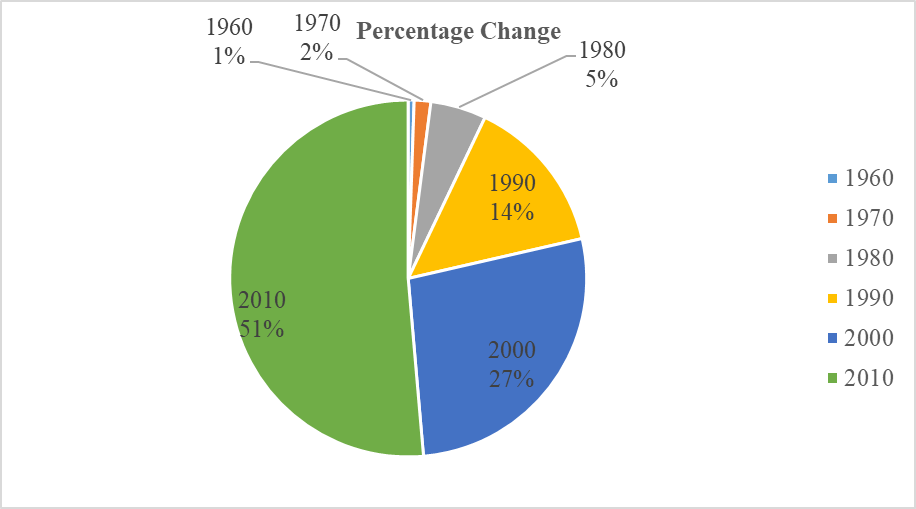The National Health Expenditure Accounts spending summarized capital spending in various aspects and sectors of administration. The search for quality healthcare delivery accounts for the change in spending over the years (Jödicke et al., 2019; Nghiem & Connelly, 2017). The cost of healthcare delivery has been rising since 1960. As found in Table 1, the total health expenditures were $ 27,359, while it rose to $74,853 by 1970. The dynamics of healthcare delivery under various sectors have evolved with changes in structural, methodological, and operational frameworks.
Table 1. Total NHE.
The national expenditures accounts categorize capital funds under the types of services, including hospital care, retail prescription drugs, residential and personal healthcare services, nursing care, home care unit, professional services, medical equipment, and non-durable medical kits, dental care, and personal care services. Figure 1 represents the NHEA spending for six specific years, including 1960, 1970, 1980, 1990, 2000, and 2010.

Resources are allocated based on the need for quality healthcare reforms, as stipulated by the NHEA legislation. The major sources of expenditures include private health insurance, Medicare, Medicaid, and out-of-pocket expenses. The rising cost in expenditures is influenced by the major sectors of capital funding, including out-of-pocket costs, health insurance, Medicare, and Medicaid. For example, the out-of-pocket expenditures in 1960 were $ 13,051, $25,015 in 1970, and $300,669 in 2010. The out-of-pocket expenditures cover the overhead cost of third-party payments, health insurance, and hospital purchases. The determinants of the high cost of healthcare expenditures vary with location, social status, and political stability. As found in Table 2, the percentage change in healthcare delivery cost rose from 1.5 percent in 1970 to 5.05 percent in 1980. The drivers of such expenses are measured by the country’s income, government fiscal status, demographic structure, disease pattern, and health system features.
Table 2. Percentage Change in NHE.
As found in Figure 1, total health expenses rose from $255,784 in 1980 to $724 277. Consequently, health care expenses in 2000 were 1,377, 167, and 2,599,000 in 2010. These drivers control the allocation of capital expenditures for quality healthcare delivery. The demographic structure describes the age categorization within a geographic location. Surveys show that the age between 5 and 65 significantly influenced the allocation of overhead costs in the healthcare system (Jödicke et al., 2019; Nghiem & Connelly, 2017). As found in Figure 2, the percentage of total expenditures rose from 27.23 % in 2000 to 51.38 % in 2010. The country’s income and the government’s fiscal status drive the cost of health care delivery. These variables, which are measured as GDP, have a natural weight on capital allocations. The country’s disease pattern and health care features represent the health care design and nature of infectious diseases.

Based on these assumptions, GDP, healthcare design, and disease patterns influence healthcare expenditures. Out-of-pocket expenditures rose between 1960 and 2010. The drivers of quality health care delivery influence the change in out-of-pocket expenses. The cost of subsidized insurance contributes to the rising NHE in the country. The rising cost of health care delivery can be reduced by abolishing unspecified charges and user fees. The government could subsidize health costs be exempted a specific age population from cost charges. Consequently, children between 0-5 and maternal healthcare could be exempted from official charges.
References
Jödicke, A. M., Zellweger, U., Tomka, I. T., Neuer, T., Curkovic, I., Roos, M., Kullak-Ublick, G. A., Sargsyan, H., & Egbring, M. (2019). Prediction of health care expenditure increase: How does pharmacotherapy contribute? BMC Health Services Research, 19(1), 1–11. Web.
Nghiem, S. H., & Connelly, L. B. (2017). Convergence and determinants of health expenditures in OECD countries. Health Economics Review, 7(1), 1-11. Web.